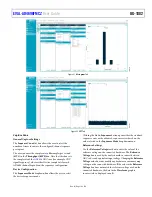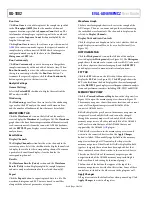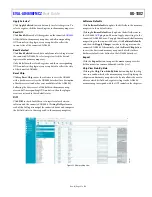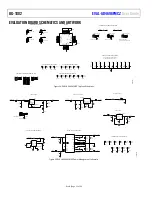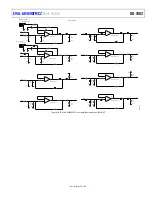
UG-1882
Rev. 0 | Page 8 of 28
regulator is enabled and supplies VDD with 1.8 V automatically on
power-up.
To configure the hardware to utilize the on-board regulator instead
of the
internal LDO regulator, the R27 resistor can be
populated with 0 Ω, connecting the (1.8 V) output of the
to VDD. The internal LDO regulator of the AD4696 can then be
disabled in the AD4696
plugin by setting the LDO_EN bit
to 0. It is worth noting that because the internal LDO regulator of
the AD4696 is enabled by default, when the EVAL-AD4696FMCZ
is powered up in this configuration, the VDD pin of the AD4696
is simultaneously driven by its internal LDO regulator and the
on-board 1.8 V supply. For this reason, the internal LDO regulator
of the AD4696 is designed to withstand being driven by an external
1.8 V supply while enabled, but it is recommended to ground the
LDO_IN input by changing the position of JP7 to ensure the
internal LDO regulator output is not driven at power-up.
See the AD4696 data sheet for more information on the
operation of the internal LDO.
Powering EVAL-AD4696FMCZ Externally
All of the active devices can be disconnected from the on-board
power circuitry on the EVAL-AD4696FMCZ to enable external
power options (for example, a bench top supply). The voltage
rails (for example, +7.5 V, +5 V, +1.8 V, and −2.5 V) can be powered
externally by removing the 0 Ω resistors at the outputs of the power
management ICs that generate them (see Table 7 for the list).
The supply pins of the on-board reference, the AD4696, and the
amplifier supply banks, can also be disconnected from the
on-board supplies in the same way. See the schematic in Figure 25
to locate the relevant components for powering each voltage rail
and component supplies.
Table 7. Resistors to Disconnect Voltage Rails from
On-Board Supplies
Supply Rail (V)
Resistor
7.5 R123
5 R129
−2.5 R130
Powering the EVAL-AD4696FMCZ with Other FMC- or
PMOD-Compatible Controller Boards
provides the 3.3 V (VCC_HOST) and
12 V supply (VPWR_12V) to the EVAL-AD4696FMCZ through
the FMC connector (P1). The EVAL-AD4696FMCZ can also be
powered by 3.3 V supplies from other FMC-compatible or
PMOD-compatible controller boards (via P1 and P30, respectively)
and by 12 V supplies through the VPWR test point (remove
R31) or via P1. Before connecting other controller boards to the
EVAL-AD4696FMCZ, ensure that their supplies are the correct
voltages and have adequate current sourcing capabilities.
The current required by the EVAL-AD4696FMCZ hardware
depends on the configuration of on-board circuitry (for example,
populated ADC driver amplifiers and number of on-board vs.
external power supplies).
DIGITAL INTERFACE
The EVAL-AD4696FMCZ provides access to the AD4696 digital
interface pins via a 160-pin field programmable gate array (FPGA)
mezzanine card (FMC) connector (P1) and alternatively via a
12-pin extended SPI PMOD-compatible connector (P30).
The AD4696 ACE plugin communicates to the EVAL-
AD4696FMCZ hardware via the SDP-H1 board through a 160-pin
FMC connector (P1). The software and hardware are designed
to quickly and easily connect and enable evaluation of the AD4696.
Alternatively, the user can use a PMOD-compatible device to
communicate with the AD4696 through P30. If the user chooses
to use a PMOD-compatible device, ensure that the pin
assignments match those on the P30 connector.
Setting the AD4696 Logic Voltage (VIO)
The output logic levels of the AD4696 are set by the voltage
applied to its VIO pin, which can range from 1.2 V to 1.8 V (see
the AD4696 data sheet for detailed VIO specifications). The
EVAL-AD4696FMCZ provides several means to drive VIO.
By default, VIO is driven by the on-board, 1.8 V LDO regulator
(U6, LT1761). Changing the position of Solder Link JP8 (see
Figure 24) allows the VADJ pin on the FMC connector (Pin G39)
to drive VIO instead. Both options are compatible with the SDP-H1
that is used in conjunction with the AD4696 evaluation software.
Using VADJ also allows the EVAL-AD4696FMCZ to interface
with third party FMC-compatible controller boards, provided
VADJ can be set within the acceptable range of the VIO pin (see
the Using Third Party Controller Boards section).
4-Wire SPI Operation
The AD4696 can be operated using only four SPI signals, if
desired, by driving CNV and CS with the same signal. The
EVAL-AD4696FMCZ enables this mode by changing the default
position of JP31. Note that the AD4696 evaluation software
does not support this option, and it is intended for use only with
third party controller boards with a 4-wire SPI peripheral (see the
Using Third Party Controller Boards section).
Using Third Party Controller Boards
The EVAL-AD4696FMCZ hardware largely follows VMEbus
International Trade Association (VITA) standards with the
FMC pin-to-signal assignments and with the board width on
the side with the FMC connector (P1). The pinout on the PMOD
connector (P30) follows the PMOD extended SPI standard. By
following these standards as much as possible, the EVAL-
AD4696FMCZ allows mating of the AD4696 with other common
controller boards. If using an FMC-compatible controller board
other than the SDP-H1, ensure that its logic levels and VADJ pin
(Pin G39) can be set to between 1.2 V and 1.8 V. It is also
recommended to use a cable to interface PMOD-compatible
controller boards to the PMOD header on the evaluation board.
Note that when using PMOD-compatible boards, it is necessary
to supply the 12 V VPWR supply externally through the VPWR
test point.



















